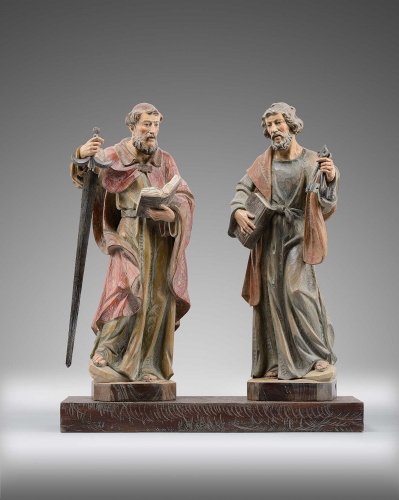Regarded as cornerstones of the Church, the feast of Saints Peter and Paul is usually celebrated with great pomp and gaiety across the state every June 29. This year’s celebrations, however, will be low-key due to the Covid-19 pandemic

Dr Alvarinho J Luis
The Catholic Church celebrates the liturgical feast to honour the martyrdom of the apostle's Peter and Paul in Rome on June 29 in AD 64. Both are patron saints of Rome and are regarded as cornerstones of the Church.
Peter was a Jew, whose original name is Simeon. He and his brother Andrew were called by Jesus to be His disciples at the beginning of his ministry (Matt 4:18). Jesus names him Cephas (in Latin) derived from Kēpa (rock in Aramaic, Jn 1:42). He was originally from Bethsaida in Galilee (John 1:44), but during the period of Jesus’ ministry, Peter lived in Capernaum, where he and his brother Andrew were engaged in fishing, along with apostles James and John, the sons of Zebedee (Lk 5:10).
Peter served as an outstanding member of the 12 disciples and enjoyed certain precedence over the other disciples. In Gospels, Peter is invariably mentioned first (Matt10:2–4; Mk3:16–19; Lk6:14–16; Acts1:13; except in Gal2:9). Those who were not immediate followers of Jesus (tax collectors) also recognized the authority of Peter, approached him for information (Matt17:24). He was quick enough to seek a clarification from Jesus on behalf of the disciples concerning the meaning of a parable (Matt15:15) and the issue of forgiveness (Matt18:21). It was Peter who displayed his depth of faith in the confession of Jesus as the Son of God (Matt16:15–18; Mk8:29; Lk9:20).
Apostle Peter was the first Pope of the Roman Church. The keys in his hand represent the divine authority that was vested before the death of Jesus in the apostle Peter. He was responsible for the documentation of much of the New Testament. Apostle Peter was crucified, and on his request, it was done upside down as he considered himself unworthy to die in the same way as Jesus. After the Roman Emperor Constantine accepted Christianity in AD313, he built a church above his grave in his honor, which is now known as St Peter’s Basilica.
Apostle Paul, whose original name was Saul of Tarsus, was one of the leaders of the first generation of Christians. He is often considered to be the most important person in the Apostolic age. Although he was a major figure within a very small Christian movement, he had many enemies/detractors, and his contemporaries probably did not accord him as much respect as they gave Peter and James. His letters have had an enormous influence on Christianity.
Paul was a member of the Pharisees (Phil3:4–6; Gal 1:13–14). He spent much of the first half of his life persecuting the Christian who accepted Jesus as the messiah. On his way to Damascus, he had a vision that changed his life (Gal 1:16) as God revealed his Son to him. This revelation convinced Paul that God had indeed chosen Jesus to be the promised messiah. He preached first in his native Syria to the Gentiles. During the next 20 years, he established several churches in Asia Minor and at least three in Europe. He was executed in Jerusalem, as part of the executions of Christians ordered by the Roman emperor Nero in 64 CE. In the surviving letters, Paul preaches the death, resurrection, and lordship of Jesus Christ and that faith in Jesus guarantees a share in His life.
Celebrations in Goa
The feast is celebrated with pomp and gaiety at Sao Pedro, Candolim, Siolim, Ribandar, Caranzalem, Agaçaim, and other places. Since St Peter is the patron of fishermen, the focus of the celebration is on the sea and fishing gears used by them. The fishermen entwine their boats which become a temporary stage with an edifice of the Church (sangodd in Konkani) for the celebration.
At Ribandar, the sangodd celebration dates back to 105 years. In the morning the procession starts from the Ajuda Church with the parish priest carrying the statue of St Peter. He gets onto the sangodd along with the brass band and some devotees. The sangodd takes a ride in the river from the jetty opposite the church to the Goa Institute Management. It returns to a small St Peter’s Chapel which is located in between Solar dos Colaço and Camelot.
The priest blesses the chapel and the river by sprinkling holy water, and the devotees sing hymns of Sts Peter and Paul. The local fishermen dip their nets into the river and pray for their safety and a good catch for the year. The sangodd returns to Patto and the entourage return to the church for the Eucharistic celebration. In the afternoon, a colorful sangodd procession is seen in the river.
In Candolim, people from Orda and Saipem celebrate the feast, with each ward having its sangodd. It starts from St Cruz Chapel in Orda, where the villagers recite prayers and sing hymns. From there, the revelers proceed to the Orda jetty and get onto the Sangodd for a cultural program. The feast is an opportunity for village unity and to showcase traditions.
In south Goa, many villages celebrate the feast. In Ambelim, the feast is celebrated at Our Lady of Lourdes Church with a Eucharistic celebration and the sangodd ride into the River Sal. The priest blesses the river and fishing nets, and everyone prays for a good catch.